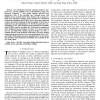Free Online Productivity Tools
i2Speak
i2Symbol
i2OCR
iTex2Img
iWeb2Print
iWeb2Shot
i2Type
iPdf2Split
iPdf2Merge
i2Bopomofo
i2Arabic
i2Style
i2Image
i2PDF
iLatex2Rtf
Sci2ools
TWC
2008
2008
Cross Layer Design for Multiaccess Communication Over Rayleigh Fading Channels
Abstract-- An information theoretic queueing model is proposed in a wireless multiple access communication setup. The proposed symmetric N user model captures physical layer parameters such as the encoding rate, transmit power and Medium Access Control (MAC) layer metrics such as queue stability. Two alternative medium access strategies are considered: centralized scheduling and ALOHA. Next, a cross-layer approach is taken wherein the maximum stable throughput of the system is achieved by a joint optimization over the MAC parameters (viz., scheduling set size with scheduling and transmission probability with ALOHA) and the encoding rate. Performance comparisons with traditional layered designs are given. It is shown that in the low and high SNR regimes, layered designs are close to optimal whereas in the moderate SNR range, cross-layer designs outperform layered schemes. Exact characterizations of the "low" and "high" SNR regimes are given quantitatively. It is also...
| Added | 16 Dec 2010 |
| Updated | 16 Dec 2010 |
| Type | Journal |
| Year | 2008 |
| Where | TWC |
| Authors | Vidyut Naware, Lang Tong |
Comments (0)

